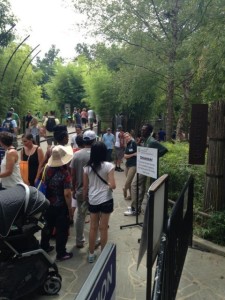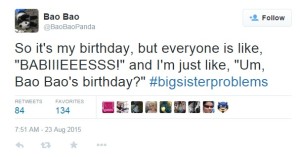It’s pure panda-mania at Washington, DC’s National Zoo…
Giant Panda Mei Xiang welcomed twin cubs Saturday.
It’s a huge draw for families – who’ve been on panda-watch pins and needles.

Melissa Metrko rushed to the zoo, Sunday morning, with her two daughters.
“What’s more exciting than the panda having a baby?” she asked. “Why not come right away?”
For Jun Gu, the meaning was even deeper. He emigrated to the U.S. 10 years ago from Shanghai, China. Sunday, he brought his wife and father-in-law, from Anhui province.
“This is the first time we see the little one!” he said. “We’re really excited!”
Gu also brought his 18-month old daughter, Annabelle to learn about her heritage.
“I want to teach her part of Chinese culture, because she’s born here,” he said, referring to the pandas as ‘old friends.’
“[It’s a] good connection between the U.S. culture and the Chinese culture.”
Chinese Expertise Key to Twin Panda Survival
Zoo staff relied heavily on the knowledge of their Chinese counterparts. Giant Pandas are primarily bred in Chengdu at the Chengdu Panda Breeding and Research Base.
“Clearly the Chinese are the experts, they have far more giant pandas, the giant panda is native only to China, ” said Copper Aitken-Palmer, Chief Veterinarian, Smithsonian National Zoo.
“We were talking all through the night with our Chinese colleagues and fortunately it was their daytime so that worked well for us so absolutely we talk to them constantly.”
Panda keepers will perform the delicate task of swapping the cubs every few hours so that each gets a chance to nurse and bond with its mother.
For now, each of the cubs is being kept in an incubator to keep their little bodies warm. Panda keepers are moving the cubs back and forth so each gets to bond with mom, Mei Xiang.
The technique, pioneered in China, has allowed several pairs of panda twins to survive in the past 10 years, including one in Atlanta.
If the cubs survive, they would be 17-year-old Mei Xiang’s third and fourth surviving offspring.
Birthday for Bao Bao
With Mei Xiang and the babies behind closed doors since the birth, the only panda zoo-goers were able to see was Bao Bao – the twins’ older sister.
She happens to be celebrating her second birthday with a giant iced fruit cake. [insert pic here]
And already tweeting about her “big sister problems.”
Even Bao Bao’s stuffed animal – is bigger than the twins. They are no longer than the length of a pen.
So far, National Zoo officials say the twin cubs are doing well. It could be months before the general public can see them in person. When Bao Bao was born in 2013, it was five months before she made her public debut. Bao Bao will return to China in two more years, making room for the twins.
 CGTN America
CGTN America
 Photo by the Smithsonian National Zoo
Photo by the Smithsonian National Zoo


